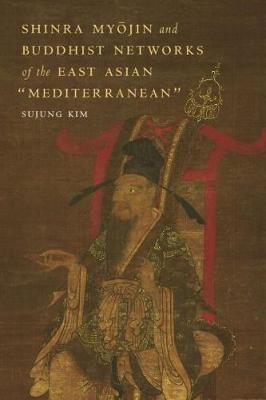
Shinra Myōjin and Buddhist Networks of the East Asian "Mediterranean
Seiten
2020
University of Hawai'i Press (Verlag)
978-0-8248-8844-2 (ISBN)
University of Hawai'i Press (Verlag)
978-0-8248-8844-2 (ISBN)
Offers a transnational account of the deity Shinra Myjin, the ""god of Silla"" worshipped in medieval Japanese Buddhism. Sujung Kim challenges the long-held understanding of Shinra Myjin as a protective deity of the Tendai Jimon school, showing how its worship emerged and developed in the complex networks of the East Asian ""Mediterranean"".
This ambitious work offers a transnational account of the deity Shinra Myōjin, the "god of Silla" worshipped in medieval Japanese Buddhism from the eleventh to sixteenth centuries. Sujung Kim challenges the long-held understanding of Shinra Myōjin as a protective deity of the Tendai Jimon school, showing how its worship emerged and developed in the complex networks of the East Asian "Mediterranean" - a "quality" rather than a physical space defined by Kim as the primary conduit for cross-cultural influence in a region that includes the Yellow Sea, the Sea of Japan (East Sea), the East China Sea, and neighbouring coastal areas. While focusing on the transcultural worship of the deity, Kim engages the different maritime arrangements in which Shinra Myōjin circulated: first, the network of Korean immigrants, Chinese merchants, and Japanese Buddhist monks in China's Shandong peninsula and Japan's Ōmi Province; and second, that of gods found in the East Asian Mediterranean. Both of these networks became nodal points of exchange of both goods and gods. Kim's examination of temple chronicles, literary writings, and iconography reveals Shinra Myōjin's evolution from a seafaring god to a multifaceted one whose roles included the god of pestilence and of poetry, the insurer of painless childbirth, and the protector of performing arts.
Shinra Myōjin and Buddhist Networks of the East Asian "Mediterranean" is not only the first monograph in any language on the Tendai Jimon school in Japanese Buddhism, but also the first book-length study in English to examine Korean connections in medieval Japanese religion. Unlike other recent studies on individual Buddhist deities, it foregrounds the need to approach them within a broader East Asian context. By shifting the paradigm from a land-centered vision to a sea-centered one, the work underlines the importance of a transcultural and interdisciplinary approach to the study of Buddhist deities.
This ambitious work offers a transnational account of the deity Shinra Myōjin, the "god of Silla" worshipped in medieval Japanese Buddhism from the eleventh to sixteenth centuries. Sujung Kim challenges the long-held understanding of Shinra Myōjin as a protective deity of the Tendai Jimon school, showing how its worship emerged and developed in the complex networks of the East Asian "Mediterranean" - a "quality" rather than a physical space defined by Kim as the primary conduit for cross-cultural influence in a region that includes the Yellow Sea, the Sea of Japan (East Sea), the East China Sea, and neighbouring coastal areas. While focusing on the transcultural worship of the deity, Kim engages the different maritime arrangements in which Shinra Myōjin circulated: first, the network of Korean immigrants, Chinese merchants, and Japanese Buddhist monks in China's Shandong peninsula and Japan's Ōmi Province; and second, that of gods found in the East Asian Mediterranean. Both of these networks became nodal points of exchange of both goods and gods. Kim's examination of temple chronicles, literary writings, and iconography reveals Shinra Myōjin's evolution from a seafaring god to a multifaceted one whose roles included the god of pestilence and of poetry, the insurer of painless childbirth, and the protector of performing arts.
Shinra Myōjin and Buddhist Networks of the East Asian "Mediterranean" is not only the first monograph in any language on the Tendai Jimon school in Japanese Buddhism, but also the first book-length study in English to examine Korean connections in medieval Japanese religion. Unlike other recent studies on individual Buddhist deities, it foregrounds the need to approach them within a broader East Asian context. By shifting the paradigm from a land-centered vision to a sea-centered one, the work underlines the importance of a transcultural and interdisciplinary approach to the study of Buddhist deities.
Sujung Kim is assistant professor of religious studies at DePauw University.
| Erscheinungsdatum | 02.11.2020 |
|---|---|
| Zusatzinfo | 10 black & white illustrations, 2 maps |
| Verlagsort | Honolulu, HI |
| Sprache | englisch |
| Maße | 152 x 229 mm |
| Themenwelt | Sachbuch/Ratgeber ► Geschichte / Politik ► Allgemeines / Lexika |
| Geisteswissenschaften ► Geschichte ► Regional- / Ländergeschichte | |
| Geisteswissenschaften ► Religion / Theologie ► Buddhismus | |
| ISBN-10 | 0-8248-8844-8 / 0824888448 |
| ISBN-13 | 978-0-8248-8844-2 / 9780824888442 |
| Zustand | Neuware |
| Haben Sie eine Frage zum Produkt? |
Mehr entdecken
aus dem Bereich
aus dem Bereich
die Reise der Menschheit : zwischen Aufbruch und Scheitern
Buch | Softcover (2023)
Ullstein Taschenbuch Verlag
14,99 €


